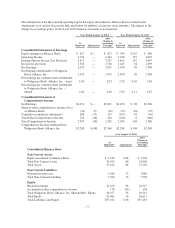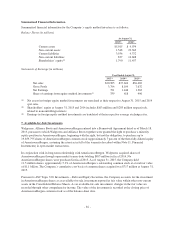Walgreens 2015 Annual Report Download - page 77
Download and view the complete annual report
Please find page 77 of the 2015 Walgreens annual report below. You can navigate through the pages in the report by either clicking on the pages listed below, or by using the keyword search tool below to find specific information within the annual report.Revenue Recognition
Revenue is recognized when: (a) persuasive evidence of an arrangement exists, (b) delivery has occurred or
services have been rendered, (c) the seller’s price to the buyer is fixed or determinable, and (d) collectability is
reasonably assured. The following revenue recognition policies have been established for the Company’s
reportable segments.
Retail Pharmacy USA and Retail Pharmacy International
The Company recognizes revenue at the time the customer takes possession of the merchandise, after making
appropriate adjustments for estimated returns. Revenue does not include sales related taxes. In certain
international locations, the Company initially estimates revenue based on expected reimbursements from
governmental agencies for dispensing prescription drugs and providing optical services. The estimates are based
on historical experience and are updated to actual reimbursement amounts.
Pharmaceutical Wholesale
Wholesale revenue is recognized upon shipment of goods, which is generally also the day of delivery. When the
Company acts in the capacity of an agent or a logistics service provider, revenue is the fee received for the
service and is recognized when the services have been performed. The Company has determined it is the agent
when providing logistics services, which is based on its assessment of the following criteria: (a) whether it is the
primary obligor in the arrangement, (b) whether it has latitude in establishing the price, changing the product or
performing part of the service, (c) whether it has discretion in supplier selection, (d) whether it is involved in the
determination of service specifications, and (e) whether it is exposed to credit risk.
Cost of Sales
Retail Pharmacy USA cost of sales is derived based upon point-of-sale scanning information with an estimate for
shrinkage and is adjusted based on periodic inventories. All other segment cost of sales includes the purchase
price of goods and services sold, store and warehouse inventory loss, inventory obsolescence, manufacturing
costs, certain direct product design and development costs and supplier rebates. In addition to product costs, cost
of sales includes manufacturing costs, warehousing costs, purchasing costs, freight costs, cash discounts and
vendor allowances.
Vendor Allowances and Supplier Rebates
Vendor allowances are principally received as a result of purchases, sales or promotion of vendors’ products.
Allowances are generally recorded as a reduction of inventory and are recognized as a reduction of cost of sales
when the related merchandise is sold. Those allowances received for promoting vendors’ products are offset
against advertising expense and result in a reduction of selling, general and administrative expenses to the extent
of advertising costs incurred, with the excess treated as a reduction of inventory costs.
Rebates or refunds received by the Company from its suppliers, mostly in cash, are considered as an adjustment
of the prices of the supplier’s products purchased by the Company.
Selling, General and Administrative Expenses
Selling, general and administrative expenses mainly consist of salaries and employee costs, occupancy costs,
depreciation and amortization, credit and debit card fees and expenses directly related to stores. In addition, other
costs included are headquarters’ expenses, advertising costs (net of vendor advertising allowances) and
insurance.
-73-
























